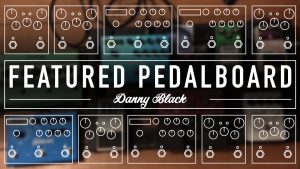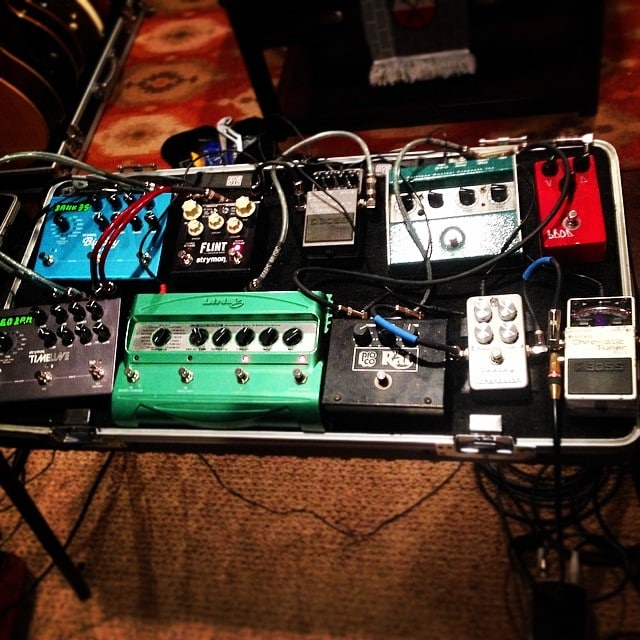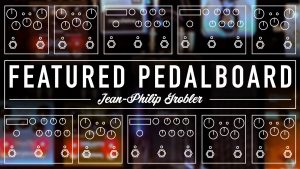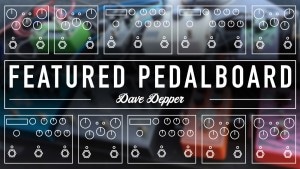
Pedalboard Feature: Danny Black
Daniel Schwartz of Good Old War has a new acoustic solo project named Danny Black. Below he shares two presets he used for his new
Free US Shipping On Orders Over $49
Easy 30-Day Returns
Financing Available Through ![]()
Hammock’s much-anticipated new album Mysterium made its sonic debut last month and its release marks the creative culmination of what has been a very busy and emotionally charged year for band members Marc Byrd and Andrew Thompson. Overcome by the loss of Byrd’s young nephew in the spring of 2016, Byrd and Thompson channeled their grief into the creation of the new record, crafting a collection of songs that serve as both memorial and celebration of the young man’s life.
We recently had a chance to talk with Hammock about their experience composing and recording Mysterium as well as their work on the score for the new film “Columbus,” which premiered at the Sundance film festival earlier this year.

You have a new album out called Mysterium; can you tell us more about its origin and the young man who inspired it?
We had originally intended to release a more electronic type of record, similar to our first record, Kenotic but after my (Marc’s) nephew passed away in April 2016 we found ourselves completely changing course. Choral music was the only type of music that I was able to listen to without falling apart emotionally. I think I found comfort in the humanity of the voices and the blending of parts… a type of hope that I could hold onto. While in the midst of awe inducing grief, the record practically began writing itself. For the longest time it was called the “Requiem record.” The title, “Mysterium” tries to convey the sense of mystery and reverence towards life and death. A mystery that is filled with both beginnings and endings…
My nephew’s name is Clark Kern. Clark suffered from Neurofibromatosis 2 (NF2), a disorder that causes tumors to form on nerves in the brain and spinal cord. My wife and I don’t have kids so I was deeply connected to Clark. Mysterium was created in memory of Clark and dedicated to my sister and her family.
What is your go-to pedal board set up and why? What is the signal chain?
To be honest, our pedal boards are almost always in flux. We are constantly changing pedals to accommodate whatever sound might be needed for a particular track.
The sequence of pedals that stay together the longest are:
Volume pedal, Tuner, Keeley compressor, old proco Rat, Expandora, Strymon Deco, hand built custom overdrive, Boss Octave, Fulltone Choral Flange, Strymon Flint, Line 6 DL4, Boss RV3, Strymon BigSky, Strymon TimeLine.

What is one of your favorite BigSky or TimeLine settings used on the new record and why?
The chorale setting on the BigSky… We used the lofi setting on the TimeLine quite a bit on this record. It was great for creating textural decaying type sounds, usually created by one of us manually turning the knobs while the other played guitar or unplugged cables. We need to credit Matthew Kidd from Slow Meadow for turning us onto the versatility of the TimeLine lofi setting.
The title track of the album features a beautiful choral arrangement; can you tell us more about the Hungarian choir you worked with and how that recording session came about?
Our mixing engineer, Francesco Donadello, had used this choir, Budapest Art Choir, many times before. A few times in person, but many more remotely. He had the highest of praise for the studio, East Connection and their team, and assured us that we could get the results we were going for out of that set up. Having already heard many of the recordings that Francesco and that choir had been involved in, it was a fairly easy decision for us to follow his recommendation.
Any tips regarding live stream recording you’d like to share?
The logistics can sometimes seem a bit overwhelming, but, for us anyway, things went incredibly smooth. We had Francesco in Berlin, our choir transcriptionist, Roman Vinuesa, in Hamburg, the actual choir and conductor in Budapest, and us in Nashville. The communication was done mostly through Skype, and the live stream recording software ran flawlessly.
It was really no different than being in a studio control room while having the conductor, Peter Pejtisk and choir in an adjacent cutting room.
You also composed the score for the film “Columbus” by Kogonada this year. How did that collaboration come about and can you tell us more about that process?
Kogonada approached us in October of 2016 with the idea of having Hammock compose the music for his film “Columbus.” He has been a fan for many years. He had recently read an interview where we were dialoguing with the interviewer about the nature of “presence and absence.” These concepts are a major theme in his work so he felt that our music would be very fitting for this film. It is a beautiful movie, with a very quiet and open sensibility. Once we had seen a rough cut, we were all in. The only hitch was that the movie had already been booked for Sundance/ January 2017, so that left us with about a month to write, record, master and get everything approved to send off to Skywalker Sound for final sound editing. So once we got started, our heads did not pop back up until the end of November. The music, as the movie, is very minimal, and we took great care to respect the space and openness of what was already on film.
Subscribe to our newsletter to be the first to hear about new Strymon products, artist features, and behind the scenes content!

Daniel Schwartz of Good Old War has a new acoustic solo project named Danny Black. Below he shares two presets he used for his new

Sometimes the word infectious can be overused. But not in the case with St. Lucia. Whether you are listening to their albums or have the

Looking for someone that enjoys talking gear? Dave Depper is your person. He said so himself here 🙂 Now with Death Cab For Cutie, Dave